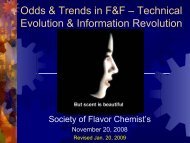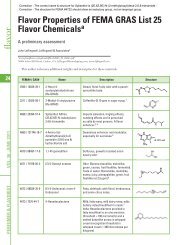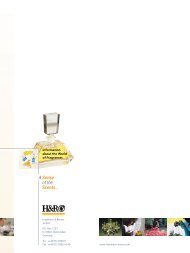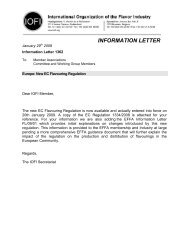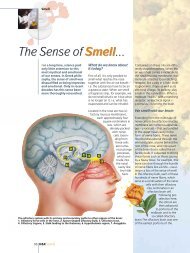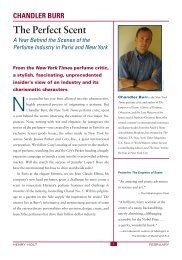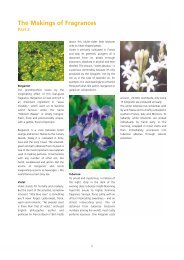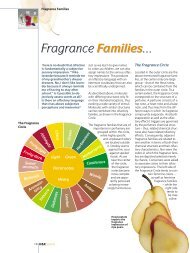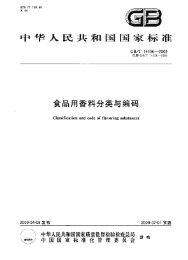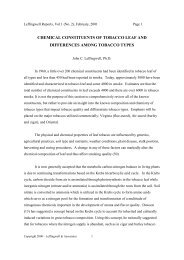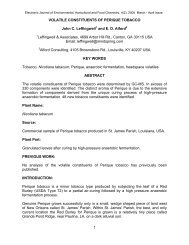Citrus Ingredients Turn Sour - Leffingwell & Associates
Citrus Ingredients Turn Sour - Leffingwell & Associates
Citrus Ingredients Turn Sour - Leffingwell & Associates
Create successful ePaper yourself
Turn your PDF publications into a flip-book with our unique Google optimized e-Paper software.
www.cropwatch.org<br />
THE FIRST TRULY INDEPENDENT WATCHDOG FOR THOSE<br />
WORKING WITH NATURAL AROMATIC MATERIALS<br />
E: info@cropwatch.org T: ++44 (0)7771 872 521<br />
Opinion:<br />
<strong>Citrus</strong> <strong>Ingredients</strong> <strong>Turn</strong> <strong>Sour</strong>: IFRA Takes the Pith!<br />
Copyright © Cropwatch Mar 2008.<br />
Executive summary:<br />
IFRA, anxious not to be seen to be behind yet another industry-stopping<br />
regulatory ingredient disaster, have this time sought to spread the<br />
responsibility for a severe limitation on (citrus) furanocoumarins in<br />
cosmetics products, via attempting a collaboration between (so-far)<br />
unidentified parties within “the industry”, and the EU Commission. The<br />
reason for the proposed furanocoumarin limitation is precautionary & not<br />
based on a tide of adverse consumer reactions, but based on fears about<br />
the incompletely understood photomutagenic & photocarcinogenic<br />
potential of individual furanocoumarins. Up to now, IFRA standards for<br />
individual citrus oils have been based on their bergapten contents, & have<br />
been universally observed by the fragrance industry. Conversely, the more<br />
recent IFRA standard of 15 ppm max of furanocoumarins in cosmetic<br />
products, has been largely ignored. The prospect that a forthcoming EU<br />
Directive would impose a 1 ppm limit for any furanocoumarins (including<br />
those not thought harmful) contained within a cosmetic product has spread<br />
concern & alarm throughout the industry about the future of citrus<br />
ingredients.<br />
Accordingly, six major marker furanocoumarins have been identified by<br />
IFRA, and their concentration in any combination within retailed fragranced<br />
cosmetics is proposed not to exceed 5 ppm for products left on the skin,<br />
and 50 ppm in wash-off products. The six chosen furanocoumarin markers<br />
are bergapten, bergamottin, byakangelicol, epoxybergamottin,<br />
isopimpinellin & oxypeucedanin. IFRA base their proposal on a stated<br />
knowledge of the toxicological profile of xanthotoxin (8-MOP), and faith in<br />
UVA filters to “eliminate the photo-toxicity of furanocoumarins”. A<br />
proposal to pioneer analytical methodology for furanocoumarin estimation<br />
by industry is also mentioned. Since three of these six marker<br />
furanocoumarins contain reactive epoxide groupings which will, for<br />
example, readily hydrate to corresponding alcohols or diols in the<br />
presence of acids (which are obviously present in citrus juices), and at
least one other is unstable in alcohol in the presence of UV-light, we can<br />
say that the furanocoumarin content of citrus oils ingredients will be<br />
processing dependent, as well as geographic location &<br />
species/subspecies dependent. Since the site of synthesis of<br />
furanocoumarins in citrus trees is not known with any degree of certainty,<br />
and since grafting is very common in the citrus plantation industry,<br />
grafting onto foreign rootstocks may throw up yet further anomalies. As it<br />
is, individual furanocoumarins may well degrade or interconvert over time<br />
in the finished fragranced product.<br />
As far as Cropwatch can reasonably ascertain, IFRA have presented a<br />
controversial, self-serving & scientifically-slanted Risk Assessment on<br />
furanocoumarins to the EU Commission for future discussion. The Risk<br />
Assessment draws on a carefully selected narrow range of evidence (you<br />
can verify this yourself from the accompanying document) and so is not<br />
scientifically neutral, but rather is sympathetic towards the IFRA-RIFM bias<br />
for toxicological imperialism, which has helped them establish their<br />
present powerful position over the industry. Not for the first time, the<br />
Assessment also apparently contains privately commissioned research<br />
material on furanocoumarin toxicity which is not available within the public<br />
domain, in apparent contradiction to the European Transparency Initiative<br />
which includes “Access to documents” - see<br />
http://ec.europa.eu/commission_barroso/kallas/transparency_en.htm. If<br />
this hidden material is eventually published after an SCCP Opinion has<br />
been formed, or a regulatory decision is adopted, any opportunity for peerreview<br />
or for criticism by interested parties ahead of the event, will have<br />
been lost. This is not in the spirit of open government.<br />
In his speech: "The European Transparency Initiative: an Issue for Berlin?"<br />
given in October 2007, Siim Kallas, European Commission Vice-President,<br />
announced that:<br />
"Transparency is neither a threat nor a judgment. It simply ensures that<br />
what we do is open to public scrutiny. If we work soundly, it will enhance<br />
our credibility - It is an opportunity, offered to the lobbying profession and I<br />
sincerely hope that it will be received as such". It is not clear to Cropwatch<br />
whether the full initiative which includes access to documents is being put<br />
into practice but it is announced on the link given above that “The<br />
Commission adopted the Green Paper on a European Transparency<br />
Initiative on 3rd May 2006” (Cropwatch is awaiting clarification on the exact<br />
status of the ruling from the Vice-president’s office).<br />
The disastrous implications for severe restrictions of natural citrus<br />
ingredients in perfumery has already been previously highlighted by<br />
Cropwatch at http://www.cropwatch.org/nlet6.htm, but up to now, the<br />
fragrance industry would have been unable to implement any new<br />
legislation based on the 6 marker furanocoumarins stipulated above,
ecause it has insufficient analytical data on their occurrence within<br />
natural perfumery ingredients. Conflicting information on furanocoumarin<br />
concentrations within natural ingredients has been previously available<br />
from IFRA/RIFM sources, data which is often at variance with scientific<br />
findings published elsewhere, & which serves to underline the high<br />
variability of furanocumarin occurrence, even within the same individual<br />
essential oil. In addition, the economic resources needed to buy<br />
sophisticated equipment to analyse natural ingredients for their<br />
furanocoumarin contents is beyond the capabilities of small companies<br />
(some furanocoumarins are too unstable to be assessed accurately by GC).<br />
Cropwatch has attempted to summarise some of the available information<br />
available to date on this topic, in an accompanying Furanocoumarins –<br />
Properties & their Distribution in Natural Aromatic <strong>Ingredients</strong>: an A-Z<br />
Listing document. IFRA’s precautionary proposal to further restrict<br />
furanocoumarins in retailed cosmetics precedes the necessary science to<br />
back it up; the situation has all the negative potential of previous EU<br />
regulatory debacles in which IFRA-RIFM played an unfortunate part e.g. the<br />
‘26 allergens’ disaster, dithering over oakmoss restriction, & the validity of<br />
the ‘quenching’ phenomena to name but three – the first-mentioned<br />
debacle costing the industry $ millions in reformulation costs, caused<br />
employment losses & loss of markets for essential oils. In addition the<br />
SCC(NF)P’s previous partiality in its Opinions with respect to<br />
furanocoumarin toxicity has been breath-taking – for example in Opinion<br />
SCCNFP/0765/03 where selective evidence on PUVA was considered<br />
(important published work on this topic was missing), & inconvenient<br />
counter-evidence was irrationally dismissed. The aroma industry cannot<br />
allow political situations like this to keep arising, we need informed<br />
judgments & decisions based on good science. It also needs to challenge<br />
IFRA’s self-appointed leadership & proposals in these matters; they are<br />
often not in the best interests of the perfumery art - they are in the best<br />
interests of toxicologists’ careers.<br />
The problem of the phototoxic potential of cosmetic products may not start<br />
& end with furanocoumarins in citrus oils, however. Hans et al. (2008)<br />
examined ten lipsticks & eight facial creams and found them to absorb<br />
UV/visible light, be photosensitising and be capable of generating reactive<br />
oxygen species. Verma et al. (2008) tested eight face creams using a<br />
DhSalpha strain of Escherichia coli as a test system for phototoxicity,<br />
finding one face cream phototoxic. Zinc oxide and titanium dioxide show<br />
photocladistic properties (Theogaraj et al. 2007, Verma et al. 2008).<br />
Strangely though, it is always the natural ingredients used in cosmetics<br />
which get the over-attention from toxicologists. You might want to ask<br />
yourself why this is, who exactly are the people responsible for this<br />
promoting policy, and what do they gain by doing it.
Dufour E.K., Kumaravel T., Nohynek G.J., Kirkland D. & Toutain H. (2006) "Clastogenicity, photoclastogenicity<br />
or pseudo-photo-clastogenicity: Genotoxic effects of zinc oxide in the dark, in preirradiated<br />
or simultaneously irradiated Chinese hamster ovary cells." Mutat Res. 607(2), 215-24.<br />
Hans R.K., Agrawal N., Verma K., Misra R.B., Ray R.S., & Farooq M. (2008) "Assessment of the<br />
phototoxic potential of cosmetic products." Food Chem Toxicol. 2008 Jan 8.<br />
Theogaraj E., Riley S., Hughes L., Maier M. & Kirkland D. (2007) "An investigation of the photoclastogenic<br />
potential of ultrafine titanium dioxide particles." Mutat Res. 634(1-2), 205-19.<br />
Verma K., Agrawal N., Misra R.B., Farooq M. & Hans R.K. (2008) "Phototoxicity assessment of drugs<br />
and cosmetic products using E. coli." Toxicol In Vitro. 22(1), 249-53.<br />
In Slightly More Detail…<br />
1. According to IFRA’s information Letter IL 799, "the industry" (participatory<br />
identities withheld, but reportedly certain citrus concerns and fragrance<br />
customers), RIFM (the industry-funded, New Jersey-based, research<br />
organisation) and the EU Commission have reportedly embarked on “a<br />
collaboration” which has resulted in a Risk Assessment on Furanocoumarins in<br />
Cosmetics which "was shared with the European Commission at the end of<br />
2007". The availability of this Risk Assessment to the general public is unclear, in<br />
itself quite unforgivable bearing in mind that this issue has unsettled & bitterly<br />
divided the essential oil business & its customers over the last 1-2 years.<br />
2. A very condensed read of IFRA’s reasoning in the Risk Assessment includes<br />
the point that much of what little we know about the photo-carcinogenic potential<br />
of furanocoumarins comes from psoralen – UVA (PUVA) treatments for psoriasis<br />
& other skin conditions, a conclusion previously muted by the UK’s Department<br />
of Health in 1998. These studies, investigating repeated PUVA patient treatments<br />
carried out with oral or topical doses of single (& sometimes impure)<br />
furanocoumarins, sometimes together with topical application of crude coal tar,<br />
under exaggerated exposure conditions on compromised skin, tell us little about<br />
the overall risk/benefits of those complex biological materials which contain a<br />
number of furanocoumarins (some with anti-carcinogenic & other beneficial<br />
properties), used for a different purpose in fragrances. It also has to be<br />
remembered that the actual mode of action of PUVA therapy is not known (Viola<br />
et al 2008), and that (in spite of the information in IFRA’s risk assessment) tar<br />
and repeated UV treatments alone also pose risks (see accompanying<br />
document). It is important therefore not to be swept away by fashionable<br />
dermatological opinion & toxicological dogma when trying to independently<br />
assess the overall risk associated with furanocoumarins in citrus oils & other<br />
products intended for a cosmetic purpose.<br />
In a separate move, IFRA recommends that the addition of UVA absorbers in<br />
fragrances will reduce photo-toxicity risk, but the addition of UV absorbers to<br />
EDT’s (eau de toilettes) & perfumes is already common practice by many<br />
perfume manufacturers, albeit carried out for colour & chemical stability reasons.<br />
Dubertret et al (1990) had previously remarked: “….despite their promising<br />
protective effect in vitro, UVB and UVA sunscreens at low concentration (0.5%-
1%) in perfumes cannot suppress the phototoxicity of bergamot oil on human<br />
skin”. There is also some evidence (ignored by IFRA) that some sunscreens<br />
have actually worsened adverse user reactions of applied fragranced products<br />
Putting these inconvenient facts to one side, it might be asked: why stop at UVA<br />
absorbers? Why not, as Cropwatch has previously suggested, also potentially<br />
modify the hazard labeling of fragrances by adding anti-irritants to perfumes<br />
containing irritating ingredients, and anti-allergens to allergen-containing<br />
perfumes?<br />
Dubertret L., Serraf-Tircazes D., Jeanmougin M., Morliere P., Averbeck D., & Young A. R. (1990)<br />
“Phototoxic properties of perfumes containing bergamot oil on human skin: Photoprotective effect<br />
of UVA and UVB sunscreens.” Journal of Photochemistry and Photobiology B: Biology 7, 251-<br />
259.<br />
Viola G, Fortunato E, Cecconet L, Del Giudice L, Dall'Acqua F, Basso G. (2008) "Central role of<br />
mitochondria and p53 in PUVA-induced apoptosis in human keratinocytes cell line NCTC-2544."<br />
Toxicol Appl Pharmacol. 227(1), 84-96.<br />
3. The IFRA Risk Assessment apparently contains several key RIFM reports on<br />
the toxicity of individual furanocoumarins which are not available in the public<br />
domain, to the best of our knowledge. Cropwatch has previously specifically<br />
asked the Regulator for two of these individual reports, but our request has so far<br />
not been fulfilled (Cropwatch understands from contacting one of the authors of<br />
the reports, and from a member of the Brussels staff, that there might be some<br />
legal wrangle over ‘ownership’). The non-publicly available reports, to the best of<br />
our belief, include the following items:<br />
Research Institute for Fragrance Materials, Inc. (2002). “Bergamottin: Reverse mutation in five<br />
histidine-requiring strains of Salmonella typhimurium, in the presence of ultra violet light. RIFM<br />
Report number 41130.” This report has been submitted to the European Commission.<br />
Research Institute for Fragrance Materials, Inc. (2007). “Bergamottin: Induction of chromosome<br />
aberrations in cultured Chinese hamster ovary (CHO) cells in the presence of ultra violet light.<br />
RIFM Report number 52420.” This report has been submitted to the European Commission.<br />
Research Institute for Fragrance Materials, Inc. (2003). “Isopimpinellin: Reverse mutation in five<br />
histidine-requiring strains of Salmonella typhimurium, in the presence of ultra violet light. RIFM<br />
Report number 42994.” This report has been submitted to the European Commission.<br />
Research Institute for Fragrance Materials, Inc. (2007). “Isopimpinellin: Induction of chromosome<br />
aberrations in cultured Chinese hamster ovary (CHO) cells in the presence of ultra violet light.<br />
RIFM Report number 52421.” This report has been submitted to the European Commission.<br />
We would refer readers to the “Access to documents” policy in the EU’s<br />
European Transparency Initiative above, but this is not a unique occurrence:<br />
looking back over several previous SCC(NF)P Opinions, decisions made on<br />
evidence within non-publicly available documents appear commonplace.<br />
4. The meat of the IFRA-RIFM proposal is to limit furanocoumarins in<br />
fragranced cosmetics to 5 ppm for leave-on products, and 50 ppm for wash-off<br />
products. Six furanocoumarin markers are to be used to estimate these levels
from natural (mainly citrus oil) sources. These are: bergapten, bergamottin,<br />
byakangelicol, epoxybergamottin, isopimpinellin & oxypeucedanin. Since coldpressed<br />
citrus oils can contain up to several thousand ppm of these materials,<br />
this proposal would pretty-well represent the end for normal citrus ingredients<br />
within alcoholic perfumery. In spite of this, IFRA have suggested that they, "the<br />
Industry", for whom it increasingly seems to be the selfappointed<br />
spokesperson, meet with DG-Enterprise/DG-Sanco "to explain &<br />
discuss its proposals in more detail.” An independent, questioning or critical voice<br />
is, apparently, not to be present at this proposed meeting. Further, from the nonscientific<br />
poll that Cropwatch has recently carried out amongst working<br />
perfumers, all have expressed the intention of not to take any notice of any<br />
further restrictions on citrus ingredients.<br />
5. The rationale of the IFRA argument in the Risk Assessment, you will not be<br />
surprised to learn, is completely biased towards that selected evidence which<br />
suits IFRA’s toxicological cause, view-point & status. An independent review of<br />
their Risk Assessment plus a full literature search is therefore absolutely<br />
essential in the interests of a correct ethical regulatory code of procedure, in case<br />
this biased Risk Assessment is subsequently spoon-fed to the SCCP ‘expert’<br />
committee. So far the track-record of SCCP Opinions on furanocoumarins has<br />
been so inexpert, that their previous Opinions have not been generally<br />
supported; indeed their findings been subsequently picked apart as impractical<br />
by all interested parties (see accompanying ‘Furanocoumarins – Properties &<br />
their Distribution in Natural Aromatic <strong>Ingredients</strong>: an A-Z Listing’ document).<br />
6. Perfumers & technologists do not have the information on furanocoumarin<br />
concentration levels within citrus & other FC-containing ingredients to be able to<br />
adhere to the 5 ppm/50 ppm restrictions mentioned above. Not only is the<br />
information not available from trade ingredient suppliers, but the methodology &<br />
associated equipment to ascertain these levels are also not available as<br />
standard, in all but the largest of the aroma mega-corporations. That information<br />
which IFRA has supplied to date on FC concentration in ingredients is often at<br />
variance with IFRA’s own previously supplied information, or published by<br />
researchers elsewhere (see accompanying ‘Furanocoumarins – Properties &<br />
their Distribution in Natural Aromatic <strong>Ingredients</strong>: an A-Z Listing’ document).<br />
Further, no processing, geographic or botanical origins are given for the natural<br />
sources of the furanocoumarins-containing ingredients by IFRA. As Couchi &<br />
Barth remarked way back in 1975, "The content of bergapten in citrus oils is<br />
difficult to specify with any certainty because its content depends on the origin of<br />
the oil and the way in which it is identified." The authors could so easily have<br />
extended this remark to other furanocoumarins such as oxypeucedanin,<br />
oxypeucedanin hydrate, bergamottin etc. but the quote illustrates the point that<br />
IFRA-RIFM supplied data to date cannot be relied on for any sort of accurate<br />
prediction of furanocoumarins levels in natural ingredients. Ultimately, they have<br />
to be determined by the user. IFRA have foreseen this consequence, and are<br />
apparently devising an analytical procedure (Spring 2008) to determine the six
marker furanocoumarins. No doubt this will end up as another example of<br />
legislatory discrimination against the interests of small companies, unable to<br />
spare the resources & expense to fulfill these proposed analytical requirements.<br />
Chouchi D. & Barth D. (1994). "Rapid identification of some coumarin derivatives in deterpenated<br />
citrus peel oil by gas chromatography" J Chromatogr A. 672(1-2), 177-83.<br />
Conclusions. So there we have it. A slanted Risk-Assessment based on only<br />
some of the evidence, and by the sounds of it, a proposal for a forthcoming<br />
stitch-up on what to do next between shadowy & currently non-identified industry<br />
moguls & compliant fragrance customers (presumably all IFRA/RIFM members),<br />
the EU Commission & IFRA-RIFM itself. The latter two parties, of course have a<br />
raison d’être, which involves the perpetual generation of safety policies to justify<br />
their salaries & positions, whether needed or not. The more curious participants<br />
in all this are the representatives from big industry, some of whom have more<br />
recently expressed their concerns to Cropwatch over the fact that safety<br />
legislation which affects natural ingredients is now out of control, and is<br />
disproportionate to the consumer risks involved. So why they didn’t oppose any<br />
attempts to restrict citrus oils in fragranced cosmetics, and help build up an<br />
alternative policy is completely beyond our understanding, but it possibly shows<br />
how bowed & emasculated industry leaders have actually become in the face of<br />
burgeoning programs of bewildering (over-) precautionary legislation.<br />
The information supplied in this Opinion document is believed to be accurate, but<br />
views, comments, criticisms, corrections or additional material can be forwarded<br />
to info@cropwatch.org for consideration in future communiqués & updates.




